cixd creative interaction design lab.
Design for Empowering People
In this research category, we aim for true human-centeredness in designing technological artifacts and services. We target to develop new methods, approaches, and design opportunities for empowering people to experience newly emerging technologies such as smart homes, wearable devices, and Internet of Things (IoT) in their own meaningful and creative ways.
Related Research Topics
-
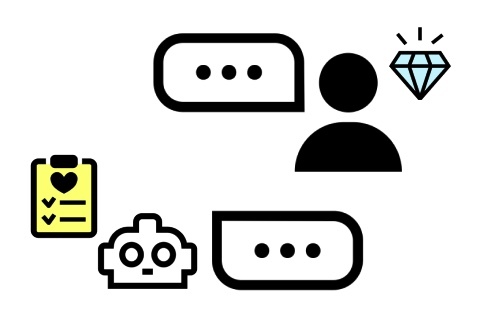 2021 - present
2021 - present
Negotiation Interaction Design for Human-centered Health Recommendations
As technologies such as wearable devices and AI develop, personalized health recommendations can be easily generated. However, if health recommendations conflict with individual values, users lose motivation to follow them. Therefore, health recommendations should take into account user interests, such as value, preference, or context. Based on this background, we propose a new interaction method called “negotiation” of intelligent agents that provides personalized health recommendations. With this new interaction method, users will receive health recommendations that reflect their values and situations. We aim to explore how users and agents negotiate and what negotiation strategies are crucial in order to provide user-centered health recommendations.
-
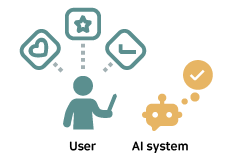 2021 - present
2021 - present
Teaching-Learning Interaction Design
Different forms of intelligent systems learn about their users to provide more personalized services through the using process. However, the learning processes of these systems are designed with little consideration of user agency, resulting in hindering users from making the best use of the system. In this project, we propose Teaching-Learning Interaction (TLI) as a new form of interaction that supports user agency by letting users reflectively shepherd an intelligent system’s manner of learning. To solidify TLI, we investigate user needs and experiences in teaching their intelligent systems from various domains (i.e., recommender systems, autonomous vehicles, etc.). For example, while users have little control of modifying the driving styles of current autonomous vehicles (AVs), the concept of TLI enables users to guide their driving-style preferences to adjust AV’s driving more fit to their needs. In our proposal, user agency is a core driving factor that is in control of AV’s learning process. While utilizing the empirical findings to develop and evaluate more detailed interaction scenarios and design guidelines for the intelligent systems, we aim to collect multiple design cases adequate for TLI proposal. Accompanied by TLI and user agency, users will be able to better personalize services for themselves.
-
 2019 - present
2019 - present
User-centered Design of User-Recommender Interaction
A recommender system has become an integral part of everyday online content platforms like Youtube, Spotify, and Instagram. Meanwhile, researchers have continuously reported user experiential issues which imply the lack of knowledge for user-centered design of user-recommender interactions (e.g., a lack of user’s sense of agency, user’s unawareness of recommender inner-workings). However, recent studies still focus on recommendation technique and its performance, and discussion on design with considerations of those user experiential issues is in its infancy. Moreover, designing for user-recommender interaction requires consideration of the contextual specificity of each platform domain. For example, although the expected user experience with the recommendation in the social network service differs from other platforms due to a unique aspect of social interaction, there is yet insufficient research on the user-recommender interaction in the social network context. This project aims to understand the user-centered design of user-recommender interactions and propose tactics for designing user-recommender interactions.
-
 2019 - 2021
2019 - 2021
Conversational Agents for Empowering People with Special Needs
Voice-based Conversational Agents (VCA) have served as personal assistants that support individuals with special needs, such as children, elders, or people with disabilities. Adolescents with Autism Spectrum Disorder (ASD) may also benefit from VCAs to deal with their everyday needs and challenges, ranging from self-care to social communications. We explored how VCAs could encourage adolescents with ASD in navigating various aspects of their daily lives through the two-week use of VCAs and a series of participatory design workshops. Our findings demonstrated that VCAs could be an engaging, empowering, emancipating tool that supports adolescents with ASD to address their needs, personalities, and expectations, such as promoting self-care skills, regulating negative emotions, and practicing conversational skills. We propose implications of using off-the-shelf technologies as a personal assistant to autistic users in Assistive Technology design. We suggest design implications for promoting positive opportunities while mitigating the remaining challenges of VCAs for adolescents with ASD.
-
 2017 - 2020
2017 - 2020
Conversational AI Assistant in Family Environment
The conversational interface has been commercialized in various forms, from assistants built into personal devices to agents in the form of artificial intelligence (AI) speakers. An agent in the form of an AI speaker is often used by multiple users in a physically shared space. Because of changes in using environments, research on conversational agents is mostly conducted on single-user personal assistants. In this project, we investigate the user experience on an AI speaker that embodies an AI assistant in a multi-user home environment. We aim to report findings of interesting experiential patterns of with-use situations and user perceptions on the AI assistant in a multi-user home environment.
-
 2017 - 2018
2017 - 2018
DIY IoT Intervention Design for Health Behavior Change
Can things in one’s household(e.g. lightings, TVs, refrigerators) help people to become more healthy? Conventional health promoting products, such as activity trackers, provide health interventions to encourage health behavior change. However, these products provide a pre-fabricated solutions for desired behavior, often dismissing the personalized needs. Contrary to proposing automated solutions for target behavior, recent works investigate the creation of user-driven solutions for effective behavior change. With the growing market of Do-it-yourself(DIY) styles in IoT products, this study attempts to apply DIY methods for creating personalized and precise health behavior change interventions. In this study, we will propose a DIY IoT intervention design tool for users to develop their own health interventions by exploring how people assemble interactions with multiple IoT devices.
-
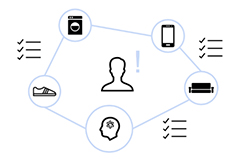 2016 - 2021
2016 - 2021
User-Centered Design for IoT
As the products obtain intelligence and are connected to each other, everyday life with things changes. The thermostat automatically regulates the temperature of house, watch orders pizza for user, and users communicate an intangible avatar, called agent. With the emergence of intelligent system such as Internet of Things (IoT), designers are facing new design paradigm shift. It provides new design opportunities to empower people and enrich their everyday life. However, intelligent systems such as IoTs focus on technical elements, and there is still lack of user-centeredness in design. To overcome these problems, design researchers are required to better understand nature of smart and connected things and their impact on users’ lives in IoT context. In this project, we aim to explore user’s mental model on IoT systems and define true user-centered design in this design space. To achieve this aim, a practically applicable level of guidelines and methodology for designing interaction with intelligent system consisting digital agents and connected things are being developed.
-
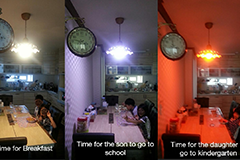 2016 - 2017
2016 - 2017
DIY Smart Home
With the development of emerging technologies for domestic environments, smart homes have received considerable research and commercial attention among ubiquitous computing communities. New types of smart home products such as do-it-yourself smart home allow users to create and modify their smart homes through do-it-yourself projects. We call these types of product do-it-yourself (DIY)-style smart home products. Users can create smart home features through DIY smart home products by connecting various sensors (e.g., a door-contact-sensor and a temperature and humidity sensor), actuators (e.g., light bulbs, sockets), social network services, SMS, and email. Because DIY smart home products are programmed and installed by the user, they provide a different experience than previous home automation products. People have to decide what smart home features they need, where to use them and how to install and program them. However, most of all, little is known about how DIY smart home products are used in daily life. Understanding the user experience of DIY smart home products could be investigated to provide a better user experience in the early stages of DIY smart home product design.
-
 2015 - 2016
2015 - 2016
Service Design for Health Behavior Change by Applying Group Goal Concept
Many researches on behavior change for health promotion has been dealt with in HCI field. Two of the most popular strategies for behavior change are goal setting and social influence which brought by other people. This study proposed a new concept of group goal, which integrates these two strategies, and explored its role in health behavior change, and found a way to apply it in service design. For this purpose, an explorative study were carried out to observe that four groups set up and accomplish group goals for four weeks. As a result, three types of group goal, the role of group goal in behavior change, and six steps for group goal utilization were derived. In the following user experience research, the six steps for group goal utilization were simulated by using existing services. As a result, step-by-step service guidelines and design considerations were suggested when applying group goals in service design. This study is meaningful in the aspect of expanding the concept of goal that are usually dealt with individual into groups, discovering the types and influences of group goal in contrast to individual goal, and proposing a new strategy to apply group goal concept on services to induce users to change behavior.
-
 2014 - 2016
2014 - 2016
Autonomous Sharing Regulation for Privacy in Health-related Personal Informatics System
Social interaction caused by sharing the personal health information has a positive influence on health behavior change. Disclosing private information, however, can arise privacy issues, and privacy issues can reduce the user’s willingness to share. This research proposed ‘User Autonomous Sharing Regulation’ that respects user privacy in health-related personal informatics system. This is not to follow rules provided a system, but to identify the user own sharing needs and privacy concerns then regulate a sharing accordingly. In order to explore the autonomous sharing regulation and to develop design knowledge for it, three user-centered studies were conducted : user interviews, user diary studies, and interviews with generative design session. Based on findings of the studies, a design framework was proposed for autonomous sharing that respects user privacy in health-related personal informatics system.
-
 2014 - 2016
2014 - 2016
FutureSelf: Forecasting the Future Health Status in QS services to Promote Health Behavior Change
In the novel A Christmas Carol, Scrooge is visited by ghosts showing his future that he will meet with a tragic end if he continues to be cold and miserly. After then, the imagination of future self transforms him into a changed man. We are to adopt this usefulness of imagining the future to help people change their health-related behavior. To investigate this issue, we began with defining the term Consequence Information as a consequence of continuing what a person has done in the past. We conducted a 4-week user study to explore how users interact with Consequence Information. Based on the findings from the study, we also conducted a workshop with designers to find out what designers focus on when designing quantified-self services providing Consequence Information. Finally, we suggested a framework for Consequence Information Quantified-Self Service Design. In addition, we produced a video that shows our interactive mirror concept design as an example of Consequence Information quantified-self service.
Video link: https://youtu.be/9oyeeE9qK58
-
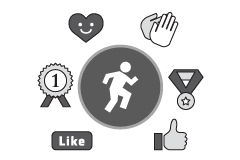 2013 - 2017
2013 - 2017
Health Behavior Change through Social Reinforcement in Health Promotion
As social networking technologies have advanced, the place where social interaction occurs has expanded through diverse social channels that connect a huge network of human resources. While the opportunities for users to connect with potential mediators who can influence the maintenance of other people’s behavior change have increased, little work exists on the social influence of those mediators and how the relationship between mediators and social channels, as well as mediators' roles and different qualities of social interaction, impact the maintenance of health behavior changes. Thus, this PhD research aims to establish a social reinforcement framework in health IT services in order to suggest guidelines for designing effective health IT services that help users to maintain their health behaviors. After a social reinforcement framework is established, an example case of health IT service using a social reinforcement framework will be developed and revised iteratively, reflecting the users' evaluations.
-
 2011 - 2017
2011 - 2017
Non-Finito Products
This research project proposes a new design space we call non-finito products. This new design space is about intentionally unfinished products and how they foster new creations by end-users as they are actually used to help people solve their own problems. The central idea comes from the background of the growing complexity associated with IT advancement and from the new way of dealing with it, with the assistance of user creativity in the actual use of the products. There is a need for the design of more user-centered, open, or flexible products to meet complex human needs, as a way of overcoming the limitations of the traditional HCI paradigm of designing finished, closed, concluded, and completed products based on the methods of function/feature analysis and focusing on meeting a user’s good mental model. We believe that non-finito products will open a new design space, prompt a new means of replacing value-destroying complexity with value-creating version, and help to make a product better fit to user experience. We should remember that there is a major difference between a completed work and a finite one: completed works are not necessary finite.
-
 2010 - 2013
2010 - 2013
Altruistic Interaction Design
The importance of design ethics in HCI has gained increasing attention the last several years. In this research, we propose a new concept of interaction that restructures its conventional notion. It is expected that this new concept will increase social empathy among people, which will eventually result in more positive ethical behaviors. This new structure of interaction breaks the current closed interaction cycle that focuses on a complete input-output feedback loop. Instead, it makes the cycle imperfect so that people cannot experience it without seeking help from others or being helped by the same. We call this concept altruistic interaction design and designed a case, the Altruistic Fan, as an applied product example. This paper explains the concept of altruistic interaction design and its application process to a real product. The study closes with the results of an exploratory user study utilizing an altruistic interaction design product (Altruistic Fan).
-
 2009 - 2014
2009 - 2014
Discovery-Driven Prototyping
DDP(discovery-driven prototyping) is a user-centered prototyping approach originally proposed by Youn-kyung Lim and her co-workers. The core idea of DDP is to provide clear functionality without pre-defined purpose-of-use and use contexts so that users by themselves could discover unexpected value of the given functions in their own lives. This research program develops and examines DDP particularly in the domain of domestic ubiquitous computing and personal life care.
-
 2009 - 2011
2009 - 2011
Calm Persuasion
We live in an environment surrounded by computers. They are used as a persuasive tool to change people’s thoughts and behaviors. In addition, Ambient Intelligence Environment is also utilized to persuade people in that environment in a stronger and more intelligent manner. Relying on various context sensing and network infrastructure, we are able to know the context a person is situated in and understand the overall information, thereby leading us to intervene and persuade just at the right time and in the right place. However, continuation of these diverse and complex persuasions can cause problems in our daily lives. The intervention and persuasion that the technology brings forth can be annoying as they occur continuously throughout the day, requiring immediate actions to take place repeatedly. Furthermore, these persuasions become bothersome obstacles while the user is working on a task. In order to overcome this problem, we propose a new approach for persuasion, namely, Calm Persuasion that could greatly reduce the cognitive load on the users and at the same time change the users’ behavior and thoughts in a natural manner.
-
 2009 - 2011
2009 - 2011
Haptics for Blind People
This project aims to improve the quality of blind people’s experience with everyday technology.
In this research category, we aim for true human-centeredness in designing technological artifacts and services. We target to develop new methods, approaches, and design opportunities for empowering people to experience newly emerging technologies such as smart homes, wearable devices, and Internet of Things (IoT) in their own meaningful and creative ways.
Related Research Topics
-
2021 - present
Negotiation Interaction Design for Human-centered Health Recommendations
As technologies such as wearable devices and AI develop, personalized health recommendations can be easily generated. However, if health recommendations conflict with individual values, users lose motivation to follow them. Therefore, health recommendations should take into account user interests, such as value, preference, or context. Based on this background, we propose a new interaction method called “negotiation” of intelligent agents that provides personalized health recommendations. With this new interaction method, users will receive health recommendations that reflect their values and situations. We aim to explore how users and agents negotiate and what negotiation strategies are crucial in order to provide user-centered health recommendations.
-
 2021 - present
2021 - present
Teaching-Learning Interaction Design
Different forms of intelligent systems learn about their users to provide more personalized services through the using process. However, the learning processes of these systems are designed with little consideration of user agency, resulting in hindering users from making the best use of the system. In this project, we propose Teaching-Learning Interaction (TLI) as a new form of interaction that supports user agency by letting users reflectively shepherd an intelligent system’s manner of learning. To solidify TLI, we investigate user needs and experiences in teaching their intelligent systems from various domains (i.e., recommender systems, autonomous vehicles, etc.). For example, while users have little control of modifying the driving styles of current autonomous vehicles (AVs), the concept of TLI enables users to guide their driving-style preferences to adjust AV’s driving more fit to their needs. In our proposal, user agency is a core driving factor that is in control of AV’s learning process. While utilizing the empirical findings to develop and evaluate more detailed interaction scenarios and design guidelines for the intelligent systems, we aim to collect multiple design cases adequate for TLI proposal. Accompanied by TLI and user agency, users will be able to better personalize services for themselves.
-
 2019 - present
2019 - present
User-centered Design of User-Recommender Interaction
A recommender system has become an integral part of everyday online content platforms like Youtube, Spotify, and Instagram. Meanwhile, researchers have continuously reported user experiential issues which imply the lack of knowledge for user-centered design of user-recommender interactions (e.g., a lack of user’s sense of agency, user’s unawareness of recommender inner-workings). However, recent studies still focus on recommendation technique and its performance, and discussion on design with considerations of those user experiential issues is in its infancy. Moreover, designing for user-recommender interaction requires consideration of the contextual specificity of each platform domain. For example, although the expected user experience with the recommendation in the social network service differs from other platforms due to a unique aspect of social interaction, there is yet insufficient research on the user-recommender interaction in the social network context. This project aims to understand the user-centered design of user-recommender interactions and propose tactics for designing user-recommender interactions.
-
 2019 - 2021
2019 - 2021
Conversational Agents for Empowering People with Special Needs
Voice-based Conversational Agents (VCA) have served as personal assistants that support individuals with special needs, such as children, elders, or people with disabilities. Adolescents with Autism Spectrum Disorder (ASD) may also benefit from VCAs to deal with their everyday needs and challenges, ranging from self-care to social communications. We explored how VCAs could encourage adolescents with ASD in navigating various aspects of their daily lives through the two-week use of VCAs and a series of participatory design workshops. Our findings demonstrated that VCAs could be an engaging, empowering, emancipating tool that supports adolescents with ASD to address their needs, personalities, and expectations, such as promoting self-care skills, regulating negative emotions, and practicing conversational skills. We propose implications of using off-the-shelf technologies as a personal assistant to autistic users in Assistive Technology design. We suggest design implications for promoting positive opportunities while mitigating the remaining challenges of VCAs for adolescents with ASD.
-
 2017 - 2020
2017 - 2020
Conversational AI Assistant in Family Environment
The conversational interface has been commercialized in various forms, from assistants built into personal devices to agents in the form of artificial intelligence (AI) speakers. An agent in the form of an AI speaker is often used by multiple users in a physically shared space. Because of changes in using environments, research on conversational agents is mostly conducted on single-user personal assistants. In this project, we investigate the user experience on an AI speaker that embodies an AI assistant in a multi-user home environment. We aim to report findings of interesting experiential patterns of with-use situations and user perceptions on the AI assistant in a multi-user home environment.
-
 2017 - 2018
2017 - 2018
DIY IoT Intervention Design for Health Behavior Change
Can things in one’s household(e.g. lightings, TVs, refrigerators) help people to become more healthy? Conventional health promoting products, such as activity trackers, provide health interventions to encourage health behavior change. However, these products provide a pre-fabricated solutions for desired behavior, often dismissing the personalized needs. Contrary to proposing automated solutions for target behavior, recent works investigate the creation of user-driven solutions for effective behavior change. With the growing market of Do-it-yourself(DIY) styles in IoT products, this study attempts to apply DIY methods for creating personalized and precise health behavior change interventions. In this study, we will propose a DIY IoT intervention design tool for users to develop their own health interventions by exploring how people assemble interactions with multiple IoT devices.
-
 2016 - 2021
2016 - 2021
User-Centered Design for IoT
As the products obtain intelligence and are connected to each other, everyday life with things changes. The thermostat automatically regulates the temperature of house, watch orders pizza for user, and users communicate an intangible avatar, called agent. With the emergence of intelligent system such as Internet of Things (IoT), designers are facing new design paradigm shift. It provides new design opportunities to empower people and enrich their everyday life. However, intelligent systems such as IoTs focus on technical elements, and there is still lack of user-centeredness in design. To overcome these problems, design researchers are required to better understand nature of smart and connected things and their impact on users’ lives in IoT context. In this project, we aim to explore user’s mental model on IoT systems and define true user-centered design in this design space. To achieve this aim, a practically applicable level of guidelines and methodology for designing interaction with intelligent system consisting digital agents and connected things are being developed.
-
 2016 - 2017
2016 - 2017
DIY Smart Home
With the development of emerging technologies for domestic environments, smart homes have received considerable research and commercial attention among ubiquitous computing communities. New types of smart home products such as do-it-yourself smart home allow users to create and modify their smart homes through do-it-yourself projects. We call these types of product do-it-yourself (DIY)-style smart home products. Users can create smart home features through DIY smart home products by connecting various sensors (e.g., a door-contact-sensor and a temperature and humidity sensor), actuators (e.g., light bulbs, sockets), social network services, SMS, and email. Because DIY smart home products are programmed and installed by the user, they provide a different experience than previous home automation products. People have to decide what smart home features they need, where to use them and how to install and program them. However, most of all, little is known about how DIY smart home products are used in daily life. Understanding the user experience of DIY smart home products could be investigated to provide a better user experience in the early stages of DIY smart home product design.
-
 2015 - 2016
2015 - 2016
Service Design for Health Behavior Change by Applying Group Goal Concept
Many researches on behavior change for health promotion has been dealt with in HCI field. Two of the most popular strategies for behavior change are goal setting and social influence which brought by other people. This study proposed a new concept of group goal, which integrates these two strategies, and explored its role in health behavior change, and found a way to apply it in service design. For this purpose, an explorative study were carried out to observe that four groups set up and accomplish group goals for four weeks. As a result, three types of group goal, the role of group goal in behavior change, and six steps for group goal utilization were derived. In the following user experience research, the six steps for group goal utilization were simulated by using existing services. As a result, step-by-step service guidelines and design considerations were suggested when applying group goals in service design. This study is meaningful in the aspect of expanding the concept of goal that are usually dealt with individual into groups, discovering the types and influences of group goal in contrast to individual goal, and proposing a new strategy to apply group goal concept on services to induce users to change behavior.
-
 2014 - 2016
2014 - 2016
Autonomous Sharing Regulation for Privacy in Health-related Personal Informatics System
Social interaction caused by sharing the personal health information has a positive influence on health behavior change. Disclosing private information, however, can arise privacy issues, and privacy issues can reduce the user’s willingness to share. This research proposed ‘User Autonomous Sharing Regulation’ that respects user privacy in health-related personal informatics system. This is not to follow rules provided a system, but to identify the user own sharing needs and privacy concerns then regulate a sharing accordingly. In order to explore the autonomous sharing regulation and to develop design knowledge for it, three user-centered studies were conducted : user interviews, user diary studies, and interviews with generative design session. Based on findings of the studies, a design framework was proposed for autonomous sharing that respects user privacy in health-related personal informatics system.
-
 2014 - 2016
2014 - 2016
FutureSelf: Forecasting the Future Health Status in QS services to Promote Health Behavior Change
In the novel A Christmas Carol, Scrooge is visited by ghosts showing his future that he will meet with a tragic end if he continues to be cold and miserly. After then, the imagination of future self transforms him into a changed man. We are to adopt this usefulness of imagining the future to help people change their health-related behavior. To investigate this issue, we began with defining the term Consequence Information as a consequence of continuing what a person has done in the past. We conducted a 4-week user study to explore how users interact with Consequence Information. Based on the findings from the study, we also conducted a workshop with designers to find out what designers focus on when designing quantified-self services providing Consequence Information. Finally, we suggested a framework for Consequence Information Quantified-Self Service Design. In addition, we produced a video that shows our interactive mirror concept design as an example of Consequence Information quantified-self service. Video link: https://youtu.be/9oyeeE9qK58
-
 2013 - 2017
2013 - 2017
Health Behavior Change through Social Reinforcement in Health Promotion
As social networking technologies have advanced, the place where social interaction occurs has expanded through diverse social channels that connect a huge network of human resources. While the opportunities for users to connect with potential mediators who can influence the maintenance of other people’s behavior change have increased, little work exists on the social influence of those mediators and how the relationship between mediators and social channels, as well as mediators' roles and different qualities of social interaction, impact the maintenance of health behavior changes. Thus, this PhD research aims to establish a social reinforcement framework in health IT services in order to suggest guidelines for designing effective health IT services that help users to maintain their health behaviors. After a social reinforcement framework is established, an example case of health IT service using a social reinforcement framework will be developed and revised iteratively, reflecting the users' evaluations.
-
 2011 - 2017
2011 - 2017
Non-Finito Products
This research project proposes a new design space we call non-finito products. This new design space is about intentionally unfinished products and how they foster new creations by end-users as they are actually used to help people solve their own problems. The central idea comes from the background of the growing complexity associated with IT advancement and from the new way of dealing with it, with the assistance of user creativity in the actual use of the products. There is a need for the design of more user-centered, open, or flexible products to meet complex human needs, as a way of overcoming the limitations of the traditional HCI paradigm of designing finished, closed, concluded, and completed products based on the methods of function/feature analysis and focusing on meeting a user’s good mental model. We believe that non-finito products will open a new design space, prompt a new means of replacing value-destroying complexity with value-creating version, and help to make a product better fit to user experience. We should remember that there is a major difference between a completed work and a finite one: completed works are not necessary finite.
-
 2010 - 2013
2010 - 2013
Altruistic Interaction Design
The importance of design ethics in HCI has gained increasing attention the last several years. In this research, we propose a new concept of interaction that restructures its conventional notion. It is expected that this new concept will increase social empathy among people, which will eventually result in more positive ethical behaviors. This new structure of interaction breaks the current closed interaction cycle that focuses on a complete input-output feedback loop. Instead, it makes the cycle imperfect so that people cannot experience it without seeking help from others or being helped by the same. We call this concept altruistic interaction design and designed a case, the Altruistic Fan, as an applied product example. This paper explains the concept of altruistic interaction design and its application process to a real product. The study closes with the results of an exploratory user study utilizing an altruistic interaction design product (Altruistic Fan).
-
 2009 - 2014
2009 - 2014
Discovery-Driven Prototyping
DDP(discovery-driven prototyping) is a user-centered prototyping approach originally proposed by Youn-kyung Lim and her co-workers. The core idea of DDP is to provide clear functionality without pre-defined purpose-of-use and use contexts so that users by themselves could discover unexpected value of the given functions in their own lives. This research program develops and examines DDP particularly in the domain of domestic ubiquitous computing and personal life care.
-
 2009 - 2011
2009 - 2011
Calm Persuasion
We live in an environment surrounded by computers. They are used as a persuasive tool to change people’s thoughts and behaviors. In addition, Ambient Intelligence Environment is also utilized to persuade people in that environment in a stronger and more intelligent manner. Relying on various context sensing and network infrastructure, we are able to know the context a person is situated in and understand the overall information, thereby leading us to intervene and persuade just at the right time and in the right place. However, continuation of these diverse and complex persuasions can cause problems in our daily lives. The intervention and persuasion that the technology brings forth can be annoying as they occur continuously throughout the day, requiring immediate actions to take place repeatedly. Furthermore, these persuasions become bothersome obstacles while the user is working on a task. In order to overcome this problem, we propose a new approach for persuasion, namely, Calm Persuasion that could greatly reduce the cognitive load on the users and at the same time change the users’ behavior and thoughts in a natural manner.
-
 2009 - 2011
2009 - 2011
Haptics for Blind People
This project aims to improve the quality of blind people’s experience with everyday technology.
Design for Experiential Qualities
In this research category, we aim for exploring, promoting, and designing aesthetically meaningful experience qualities in use of interactive artifacts. We target to develop new theories, methods, approaches, and tools to enable interaction designers and developers to tangibly and creatively explore and manifest invisible and dynamic qualities of interactivity of an interactive device.
Related Research Topics
-
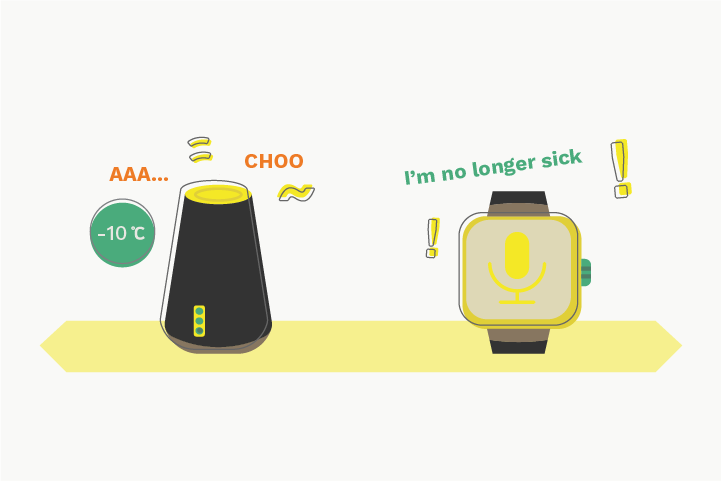 2020 - 2022
2020 - 2022
Humanlikeness in AI Services
TBD
-
 2019 - 2021
2019 - 2021
Reflective Experience Design for Recommender Systems
Recommendation systems (RSs) are very closely embedded in our lives, and among the numerous information, they selectively present personalized information to users. Such systems help users make innumerable decisions in the choices they face. However, the current system provides recommendations based on the user's behavioral data, which only accepts what is given and does not help them think about what they want. For such user limitations, this present work explores the possibility of designing RSs that can engage reflective experience. It allows users to build a system in a user-centered way rather than passively using an RS and will enable users to mutually benefit from intelligence, providing a better interaction for both the system and the user. Through historical photo-description data collection, designer workshops, and user interviews, we offer a reflective RS experience and revealed findings focusing on new user experiences that arise compared to traditional RSs. Based on this, we find that a reflective RS is possible, and we conclude the paper with discussions for designing RSs that engage the user in reflection.
-
 2017 - 2019
2017 - 2019
Designing for Consistent Personalities of Conversational Agents
Along with the wide prevalence of human-like conversational agents such as Siri, Google, Alexa, and Bixby, designing personalities of such agents has become a key research interest. As agent personalities are crucial to determining how they perceive the agent, how satisfying the interaction is, and whether they wish to interact with it again, it is not surprising that building a consistent personality of a CA is receiving emphasis as a crucial part of designing a user-agent interaction. For an agent personality to be manifested consistently, those who design such personality should be able to deliver it concretely enough to those who write actual dialogs to enable a shared understanding of the intended personality. In light of this issue, this research aims to develop a design guide for consistent manifestation of agent personalities by exploring the ways to design and express them in order to be clearly communicated among various designers.
-
 2016 - 2019
2016 - 2019
Understanding Stress on Mobile Instant Messengers
In text communication service, mobile instant messenger (MIM) has now moved beyond email, SMS and more. With the popularization of smartphones, MIMs which feature no-cost and convenience such as Kakaotalk, Line, and WhatsApp have grown tremendously. Nowadays, numerous people are interacting with MIM, and the range is being used not only for everyday conversations, but also for business communication. As the use of MIM expands, people getting stress from MIM is increasing. In South Korea, the penetration rate of smartphones is over 91%. MIM is used pervasively even in public societies such as schools and companies, and MIM stress has become a serious social problem. We are currently working on a study to understand the phenomenon and cause of MIM stress.
-
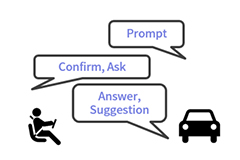 2015 - 2017
2015 - 2017
Designing In-car Voice User Interface Dialogue
With the development of Natural Language Processing (NLP) technology, more devices are being controlled by human’s natural speech. Since voice-controlled devices do not need visual attention of the users at the time of usage, vehicle manufacturers, especially automobile companies, are adopting the system, with more and more information to give to the drivers while driving. But since Voice (or Speech) User Interface (VUI) is somewhat unfamiliar to most of the drivers who are used to conventional control systems, they find it difficult to interact or even start interacting with the systems. At the same time, interface designers do not have any common framework and guidelines upon which to design VUIs, thus they often struggle to achieve their goals to meet drivers’ needs. Since VUI has no forms that can be seen and give a clue of how to be used, interface designers should carefully and systematically design not only the system but also the dialogue structure and flow. This research aims to provide a framework and guidelines for VUI designers on how to design the dialogue between the user and the interface of automobile VUIs under the context of inside automobiles with a driver driving.
-
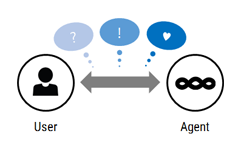 2014 - 2019
2014 - 2019
Designing Evolving Interactions for Intelligent Assistant Systems
Smart products and services around us are increasingly becoming intelligent in supporting our everyday lives. Like personal assistants, they aim to provide personalized assistance so that individual users can more effectively manage their schedules and events, health and behaviors, and social relationships with others. In addition, these assistant-like systems have great potentials to evolve over time, as they can learn about their users and improve the services in a way that are more fit to individual users. Meanwhile, it is important to make such evolution not just led by technologies, but by deeply understanding users’ experiences of these evolving systems in a human-centered perspective, because algorithm-driven service evolution may not always be relevant, necessary, and pleasant in a given user’s own life contexts. However, research on designing interactions with evolving intelligent systems and user experience is still in its early stage. As a step forward to fill this gap, this research investigates what users think as a meaningful evolution of intelligent assistant systems and how they would like to collaborate with the systems to make such evolution possible. By doing so, this research aims to provide theoretical and practical knowledge for designing intelligent assistant systems, which truly support people and provide pleasant experiences of the systems.
-
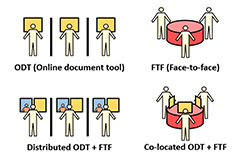 2014 - 2018
2014 - 2018
Influences of Media Affordances on Collaborative Design Process
“Affordance” was introduced to HCI by Donald A. Norman in the late 1980s and quickly became one of the field’s key concepts, widely used by researchers, educators, and practitioners. In particular, in terms of collaborative working, affordances have been used as tools to understand and describe the different characteristics of media. However, affordances of media would not play the same role every time. Even the same affordance can cause different collaboration behaviors and phenomena depending on the context used. In this reason, to use media effectively, we need to understand media affordances and their influences on specific contexts. Especially, design problems tend to be large and complex, and include various characteristics of activities. Accordingly, it is critical to exploit appropriate media and their affordances at the stage of collaborative design process to solve design problems. However, there are few projects that directly address how media affordances affect the collaborative design process. The aim of this research project is to reveal the influences of media on the collaborative design process. More specifically, we identify compelling media affordances for design collaboration from a comparative study of online document tools and face-to-face interaction, and analyze their effects on designers’ interaction and each design problem-solving activities. By doing so, we will provide implications for designing appropriate media to support effective design collaboration.
-
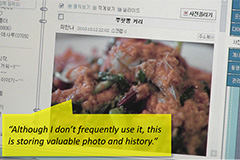 2012 - 2013
2012 - 2013
Value Construction with Digital Things
People develop strong attachments to a small selection of the things they encounter in their life. We live in a world increasingly filled with digital things. Some of these digital things are simply physical things that have lost their physical form, such as photos, music, video, and even money. Some are things that never had a lasting physical form, such as email, text, and IM message archives; social networking profile pages including status messages and comments; and personal behavior logs from services such as MapMyRun or FourSquare. Interestingly, digital objects seem different. Imagine a parent reading to a child on a Kindle. Years later would that parent still keep and cherish the device? Or would they cherish a specific digital file? It seems unlikely. We aimed to investigate the opportunities for new products and services to help people to better create, access, and construct value with their digital things. Specifically, we conducted field studies and technology probes with young adults in Europe, North America, and Asia. As a result, we identified the more universal and more culturally specific aspects of value construction with digital things. Based on our findings, we generated ideas for emerging service opportunities at the intersection of cloud, social, and mobile computing in the design of new products and services that help people perceive more value in their digital things.
-
 2010 - 2012
2010 - 2012
Interactivity Preferences & Customization
In the use of social networking services, crafting one’s identity is one of the fundamental activities that enable people to interact with others as unique individuals. The early SNSs like MySpace and Cyworld provided many visual features such as profile decoration and avatar customization so that people can expressively portrait and distinguish themselves from others. However, as a new trend of SNSs (SNS 2.0) emerge over recent several years, which needs to be visually simplistic to effectively support real time contents sharing, those visual features has been replaced by text-oriented contents, although individuals still want to express his/her characteristics without verbally articulating the details.
In this new context, this study explores the potential of interactivity, the dynamic characteristics of interactive artifacts, as a new medium for self-expression in online communication. To do so, we first investigated whether people have preferences toward interactivity and how they are related to one’s personality. Then, we developed a social website where people can express themselves through interactivity and experience others through their interactivity expressions. Based on the understandings from the user study, practical design implications were discussed so that designers are able to strategically utilize interactivity for self-expression in online communication.
-
 2008 - 2015
2008 - 2015
Interactivity Attributes
We have conducted a set of studies to enable interaction designers and researchers to concretely articulate and craft the dynamic and invisible qualities of interactive products, which we call interactivity. In this project, we developed a theoretical framework that describes interactivity attributes and investigated its effects on the ways designers think and create interactive products. Also, we developed new prototyping tools that enable interaction designers and developers to tangibly and creatively explore and manifest invisible and dynamic qualities of interactivity, without being tied in any specific forms of interfaces such as graphical user interfaces, tangible user interfaces, touch interfaces, and gestural interfaces.
In this research category, we aim for exploring, promoting, and designing aesthetically meaningful experience qualities in use of interactive artifacts. We target to develop new theories, methods, approaches, and tools to enable interaction designers and developers to tangibly and creatively explore and manifest invisible and dynamic qualities of interactivity of an interactive device.
Related Research Topics
-
 2020 - 2022
2020 - 2022
Humanlikeness in AI Services
TBD
-
 2019 - 2021
2019 - 2021
Reflective Experience Design for Recommender Systems
Recommendation systems (RSs) are very closely embedded in our lives, and among the numerous information, they selectively present personalized information to users. Such systems help users make innumerable decisions in the choices they face. However, the current system provides recommendations based on the user's behavioral data, which only accepts what is given and does not help them think about what they want. For such user limitations, this present work explores the possibility of designing RSs that can engage reflective experience. It allows users to build a system in a user-centered way rather than passively using an RS and will enable users to mutually benefit from intelligence, providing a better interaction for both the system and the user. Through historical photo-description data collection, designer workshops, and user interviews, we offer a reflective RS experience and revealed findings focusing on new user experiences that arise compared to traditional RSs. Based on this, we find that a reflective RS is possible, and we conclude the paper with discussions for designing RSs that engage the user in reflection.
-
 2017 - 2019
2017 - 2019
Designing for Consistent Personalities of Conversational Agents
Along with the wide prevalence of human-like conversational agents such as Siri, Google, Alexa, and Bixby, designing personalities of such agents has become a key research interest. As agent personalities are crucial to determining how they perceive the agent, how satisfying the interaction is, and whether they wish to interact with it again, it is not surprising that building a consistent personality of a CA is receiving emphasis as a crucial part of designing a user-agent interaction. For an agent personality to be manifested consistently, those who design such personality should be able to deliver it concretely enough to those who write actual dialogs to enable a shared understanding of the intended personality. In light of this issue, this research aims to develop a design guide for consistent manifestation of agent personalities by exploring the ways to design and express them in order to be clearly communicated among various designers.
-
 2016 - 2019
2016 - 2019
Understanding Stress on Mobile Instant Messengers
In text communication service, mobile instant messenger (MIM) has now moved beyond email, SMS and more. With the popularization of smartphones, MIMs which feature no-cost and convenience such as Kakaotalk, Line, and WhatsApp have grown tremendously. Nowadays, numerous people are interacting with MIM, and the range is being used not only for everyday conversations, but also for business communication. As the use of MIM expands, people getting stress from MIM is increasing. In South Korea, the penetration rate of smartphones is over 91%. MIM is used pervasively even in public societies such as schools and companies, and MIM stress has become a serious social problem. We are currently working on a study to understand the phenomenon and cause of MIM stress.
-
 2015 - 2017
2015 - 2017
Designing In-car Voice User Interface Dialogue
With the development of Natural Language Processing (NLP) technology, more devices are being controlled by human’s natural speech. Since voice-controlled devices do not need visual attention of the users at the time of usage, vehicle manufacturers, especially automobile companies, are adopting the system, with more and more information to give to the drivers while driving. But since Voice (or Speech) User Interface (VUI) is somewhat unfamiliar to most of the drivers who are used to conventional control systems, they find it difficult to interact or even start interacting with the systems. At the same time, interface designers do not have any common framework and guidelines upon which to design VUIs, thus they often struggle to achieve their goals to meet drivers’ needs. Since VUI has no forms that can be seen and give a clue of how to be used, interface designers should carefully and systematically design not only the system but also the dialogue structure and flow. This research aims to provide a framework and guidelines for VUI designers on how to design the dialogue between the user and the interface of automobile VUIs under the context of inside automobiles with a driver driving.
-
 2014 - 2019
2014 - 2019
Designing Evolving Interactions for Intelligent Assistant Systems
Smart products and services around us are increasingly becoming intelligent in supporting our everyday lives. Like personal assistants, they aim to provide personalized assistance so that individual users can more effectively manage their schedules and events, health and behaviors, and social relationships with others. In addition, these assistant-like systems have great potentials to evolve over time, as they can learn about their users and improve the services in a way that are more fit to individual users. Meanwhile, it is important to make such evolution not just led by technologies, but by deeply understanding users’ experiences of these evolving systems in a human-centered perspective, because algorithm-driven service evolution may not always be relevant, necessary, and pleasant in a given user’s own life contexts. However, research on designing interactions with evolving intelligent systems and user experience is still in its early stage. As a step forward to fill this gap, this research investigates what users think as a meaningful evolution of intelligent assistant systems and how they would like to collaborate with the systems to make such evolution possible. By doing so, this research aims to provide theoretical and practical knowledge for designing intelligent assistant systems, which truly support people and provide pleasant experiences of the systems.
-
 2014 - 2018
2014 - 2018
Influences of Media Affordances on Collaborative Design Process
“Affordance” was introduced to HCI by Donald A. Norman in the late 1980s and quickly became one of the field’s key concepts, widely used by researchers, educators, and practitioners. In particular, in terms of collaborative working, affordances have been used as tools to understand and describe the different characteristics of media. However, affordances of media would not play the same role every time. Even the same affordance can cause different collaboration behaviors and phenomena depending on the context used. In this reason, to use media effectively, we need to understand media affordances and their influences on specific contexts. Especially, design problems tend to be large and complex, and include various characteristics of activities. Accordingly, it is critical to exploit appropriate media and their affordances at the stage of collaborative design process to solve design problems. However, there are few projects that directly address how media affordances affect the collaborative design process. The aim of this research project is to reveal the influences of media on the collaborative design process. More specifically, we identify compelling media affordances for design collaboration from a comparative study of online document tools and face-to-face interaction, and analyze their effects on designers’ interaction and each design problem-solving activities. By doing so, we will provide implications for designing appropriate media to support effective design collaboration.
-
 2012 - 2013
2012 - 2013
Value Construction with Digital Things
People develop strong attachments to a small selection of the things they encounter in their life. We live in a world increasingly filled with digital things. Some of these digital things are simply physical things that have lost their physical form, such as photos, music, video, and even money. Some are things that never had a lasting physical form, such as email, text, and IM message archives; social networking profile pages including status messages and comments; and personal behavior logs from services such as MapMyRun or FourSquare. Interestingly, digital objects seem different. Imagine a parent reading to a child on a Kindle. Years later would that parent still keep and cherish the device? Or would they cherish a specific digital file? It seems unlikely. We aimed to investigate the opportunities for new products and services to help people to better create, access, and construct value with their digital things. Specifically, we conducted field studies and technology probes with young adults in Europe, North America, and Asia. As a result, we identified the more universal and more culturally specific aspects of value construction with digital things. Based on our findings, we generated ideas for emerging service opportunities at the intersection of cloud, social, and mobile computing in the design of new products and services that help people perceive more value in their digital things.
-
 2010 - 2012
2010 - 2012
Interactivity Preferences & Customization
In the use of social networking services, crafting one’s identity is one of the fundamental activities that enable people to interact with others as unique individuals. The early SNSs like MySpace and Cyworld provided many visual features such as profile decoration and avatar customization so that people can expressively portrait and distinguish themselves from others. However, as a new trend of SNSs (SNS 2.0) emerge over recent several years, which needs to be visually simplistic to effectively support real time contents sharing, those visual features has been replaced by text-oriented contents, although individuals still want to express his/her characteristics without verbally articulating the details. In this new context, this study explores the potential of interactivity, the dynamic characteristics of interactive artifacts, as a new medium for self-expression in online communication. To do so, we first investigated whether people have preferences toward interactivity and how they are related to one’s personality. Then, we developed a social website where people can express themselves through interactivity and experience others through their interactivity expressions. Based on the understandings from the user study, practical design implications were discussed so that designers are able to strategically utilize interactivity for self-expression in online communication.
-
 2008 - 2015
2008 - 2015
Interactivity Attributes
We have conducted a set of studies to enable interaction designers and researchers to concretely articulate and craft the dynamic and invisible qualities of interactive products, which we call interactivity. In this project, we developed a theoretical framework that describes interactivity attributes and investigated its effects on the ways designers think and create interactive products. Also, we developed new prototyping tools that enable interaction designers and developers to tangibly and creatively explore and manifest invisible and dynamic qualities of interactivity, without being tied in any specific forms of interfaces such as graphical user interfaces, tangible user interfaces, touch interfaces, and gestural interfaces.